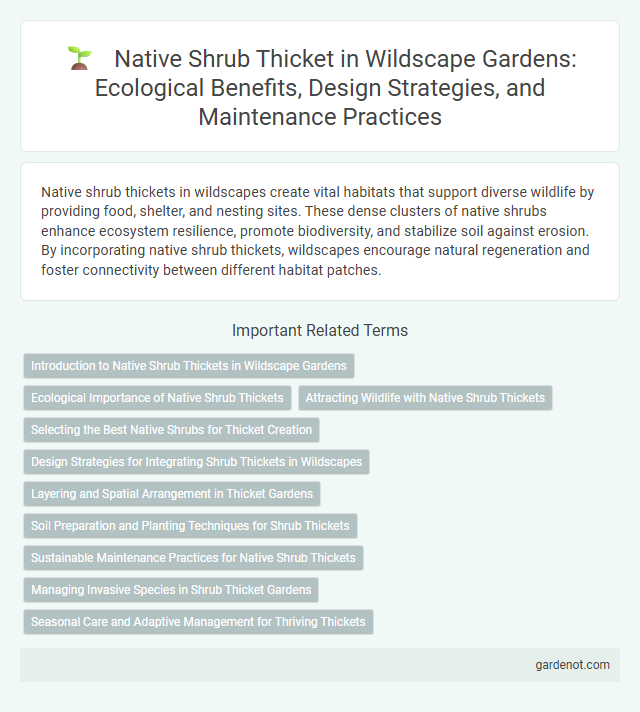Native shrub thickets in wildscapes create vital habitats that support diverse wildlife by providing food, shelter, and nesting sites. These dense clusters of native shrubs enhance ecosystem resilience, promote biodiversity, and stabilize soil against erosion. By incorporating native shrub thickets, wildscapes encourage natural regeneration and foster connectivity between different habitat patches.
Introduction to Native Shrub Thickets in Wildscape Gardens
Native shrub thickets in Wildscape gardens provide essential habitat complexity that supports local biodiversity and enhances ecological resilience. These dense clusters of native shrubs improve soil stability, promote water retention, and offer shelter and food resources for native wildlife such as birds, insects, and small mammals. Incorporating native shrub thickets into Wildscape designs fosters sustainable ecosystems by mimicking natural plant communities and encouraging native species interactions.
Ecological Importance of Native Shrub Thickets
Native shrub thickets provide critical habitat for numerous bird species, small mammals, and pollinators, enhancing biodiversity within wildscapes. Their dense structure offers shelter and nesting sites, while root systems stabilize soil and prevent erosion, contributing to ecosystem resilience. These thickets also support nutrient cycling and improve water retention, playing a vital role in maintaining healthy forest and grassland ecosystems.
Attracting Wildlife with Native Shrub Thickets
Native shrub thickets create dense, protective habitats that attract a variety of wildlife, including songbirds, small mammals, and pollinators. These thickets offer essential food sources such as berries and nectar, supporting biodiversity by sustaining native animal populations. Planting species like elderberry, serviceberry, and spicebush enhances ecological balance and encourages natural wildlife interactions in wildscape environments.
Selecting the Best Native Shrubs for Thicket Creation
Selecting the best native shrubs for thicket creation involves prioritizing species that provide dense foliage, wildlife habitat, and ecological benefits. Examples of ideal native shrubs include serviceberry (Amelanchier spp.), elderberry (Sambucus spp.), and spicebush (Lindera benzoin), which thrive in local soil and climate conditions while supporting pollinators and bird populations. Incorporating a mix of these shrubs enhances biodiversity, offers seasonal food sources, and promotes natural landscape resilience.
Design Strategies for Integrating Shrub Thickets in Wildscapes
Design strategies for integrating native shrub thickets in wildscapes emphasize selecting indigenous species that support local wildlife and promote biodiversity. Incorporating multilayered planting techniques enhances habitat complexity, providing shelter and food sources for pollinators, birds, and small mammals. Strategic placement along edges and transitional zones optimizes ecological connectivity and natural aesthetics within the landscape.
Layering and Spatial Arrangement in Thicket Gardens
Native shrub thickets exhibit complex layering with multiple vegetation strata, including ground covers, understory shrubs, and taller woody plants, creating diverse habitats in Wildscape gardens. Carefully planned spatial arrangement promotes natural density gradients and interlocking canopies, enhancing ecological functions such as shelter, food sources, and microclimate regulation. This structural complexity supports greater biodiversity, encouraging native wildlife and improving garden resilience.
Soil Preparation and Planting Techniques for Shrub Thickets
Proper soil preparation for native shrub thickets involves deep tilling to improve soil aeration and drainage, combined with organic matter incorporation to enhance nutrient content. Planting techniques emphasize spacing shrubs to mimic natural density, ensuring adequate root growth and facilitating biodiversity. Mulching around the base of shrubs helps retain moisture, suppress weeds, and promote healthy root establishment in native habitats.
Sustainable Maintenance Practices for Native Shrub Thickets
Sustainable maintenance practices for native shrub thickets prioritize minimal disturbance to soil and native biodiversity, using techniques such as selective pruning and mulching with organic materials to conserve moisture and enhance soil health. Incorporating native pollinator-friendly plants and avoiding chemical herbicides supports ecological balance and promotes habitat resilience. Regular monitoring for invasive species and implementing adaptive management ensure long-term sustainability and thriving native shrub ecosystems.
Managing Invasive Species in Shrub Thicket Gardens
Effective management of invasive species in native shrub thicket gardens is crucial for preserving biodiversity and ecosystem health. Implementing targeted removal of invasive plants such as Japanese honeysuckle and multiflora rose helps maintain the dominance of native species like spicebush and witch hazel. Regular monitoring and the use of native mulch can suppress invasive seedling growth, fostering a resilient and sustainable shrub thicket habitat.
Seasonal Care and Adaptive Management for Thriving Thickets
Seasonal care of native shrub thickets involves strategic pruning and mulching to promote healthy growth and prevent disease during dormant and active periods. Adaptive management practices include monitoring growth patterns and soil moisture levels to adjust irrigation and nutrient application, ensuring resilience against climate fluctuations. Incorporating native species' natural growth cycles supports thriving thickets that provide essential habitat and biodiversity benefits in wildscapes.
Native shrub thicket Infographic

 gardenot.com
gardenot.com